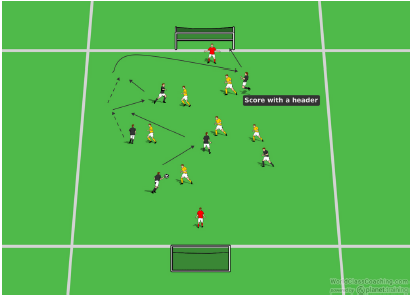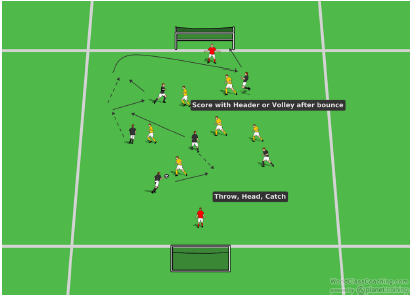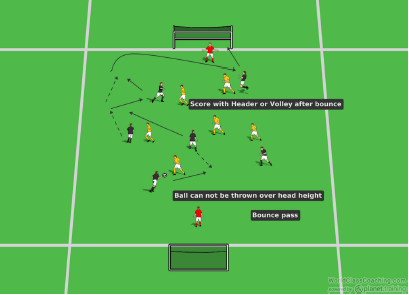By Sean Reed -
Objective
This session is a directional throw catch game. Similar to throw catch possession, but is working towards a goal and within a shape.
Session 1

Diagram 1
Set Up
- A session which can be used with a different number of players
- Two teams split with 2x GK
- Pitch size is dependent on the number of players
- Throw catch working towards goal
- A player is not allowed to run with the ball. Is only allowed to make a step on receiving a pass
- The ball is turned over if it hits the ground, the ball is out of play or the opposition intercept
- To score a player must head the ball into the goal, from a throw
Progression
- Score with a volley
- Allow the ball to bounce before final contact on goal
Coaching Points
- Tempo of passing
- Movement to receive the ball, angles of support
- Tempo of movement
- Awareness of movement and forward runs
- Awareness of the next pass before the ball is received
- Tracking runners
- End product in front of goal
Session 2

Diagram 2
[wpsharely id="1204"][/wpsharely]
Set Up
- As within the previous session
- The passing sequence is player (1) throws to player (2) who heads to the next player, who catches then throws.
- A goal can be scored with either a head or a volley
- The ball can bounce before a header or volley to score
Progression
- Throw volley, catch (as with the throw head, catch)
Coaching Points
- • As within previous session
• Movement to support the header/volley
• Movement to come short or go long
• Direction and power when the header is played
• Communication
Session 3

Diagram 3
Set Up
- Set up as with the previous session (session 3)
- Start with throw catch, then move to head and volley throw catch. This time the pass cannot be played over-head height, but the ball can bounce once. It will encourage players to move and recognize a good supporting angle
Progression
- Head catch. Player catches and serves to themselves to head the ball to make a pass
- Volley catch. Player catches and serves to themselves to volley the ball to make a pass
- As above but before the ball is caught, the player must take 1 touch to control the ball (i.e. chest, thigh then catch)
Coaching Points
- As within previous sessions
- Quality with the header and volley – type and weight of pass
- Movement and angles to support the ball
By Sean Reed
Former First Team Coach of Championship side Fulham FC. Sean is a UEFA A Coach with a Masters in Sport Coaching. He has over 15 years of experience working in professional football from Academy through to First team in the Premiership and Championship.
Linkedin - www.developmentofplayers.com
Twitter - @SeanJReed


